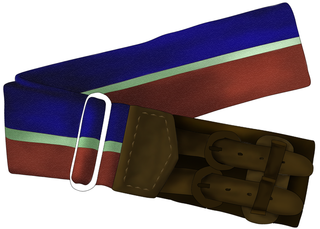
A stable belt is a striped coloured belt worn at times by the armed forces of the United Kingdom and other Commonwealth countries – and a few other countries such as Denmark, Brazil and Lebanon. The stripes identify and vary by regiment and corps. In Brazil and Lebanon they are known as gymnastic belts.

The Royal New Zealand Infantry Regiment is the parent administrative regiment and corps of regular and reserve infantry battalions in the New Zealand Army. It was originally formed in 1947 with a singular Regular regiment and multiple reserve regiments. Over time, the regiments were turned into battalions, the reserve units amalgamated and more regular units raised and disbanded. Currently, the Regiment currently consists of two regular and three reserve battalions. Throughout its existence, units raised in this regiment have served and deployed on operations in Malaya, Vietnam, Borneo and various United Nations peacekeeping operations.
The Wellington and Hawke's Bay Regiment was a Territorial Force regiment of the New Zealand Army. It was formed in 1964 during the reorganisation of the army by the amalgamation of two separate regiments:
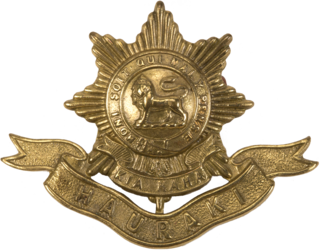
The Hauraki Regiment was a Territorial Force unit of the New Zealand Army. The regiment was formed as the 2nd (Hauraki) Battalion, Auckland Rifle Volunteers. Men of the Hauraki Regiment served during the First World War with the various Auckland Regiments, and with the 18th, 21st, 24th and 29th Battalions of the NZEF in the Second World War.
The 3rd Battalion, Auckland and Northland Regiment was a Territorial Force Battalion of the Royal New Zealand Infantry Regiment, with headquarters in Arch Hill Auckland Army Centre. The unit consists of company-sized units which have their headquarters in Auckland and Whangarei. The unit was part of Training and Doctrine Command (TRADOC) headquartered at Waiouru.

The Canterbury, and Nelson-Marlborough and West Coast Regiment was a Territorial Force unit of the New Zealand Army.
The Wellington West Coast and Taranaki Regiment was a Territorial Force unit of the New Zealand Army. It was originally formed in 1948 by the amalgamation of two separate regiments:
The Otago and Southland Regiment (1948-2012) was a Territorial Force unit of the New Zealand Army. It saw service from 1959-1963 during the Malayan Emergency. In 1964 the unit was renamed the 4th Otago and Southland Battalion Group. The Regiments motto was Kia Mate Toa and Regimental Belt had the Mackenzie Tartan pattern of the Queen's Own Highlanders. The regimental badge uniquely contained a full Māori chief.

The York and Lancaster Regiment was a line infantry regiment of the British Army that existed from 1881 until 1968. The regiment was created in the Childers Reforms of 1881 by the amalgamation of the 65th Regiment of Foot and the 84th Regiment of Foot. The regiment saw service in many small conflicts and both World War I and World War II until 1968, when the regiment chose to be disbanded rather than amalgamated with another regiment, one of only two infantry regiments in the British Army to do so, with the other being the Cameronians.
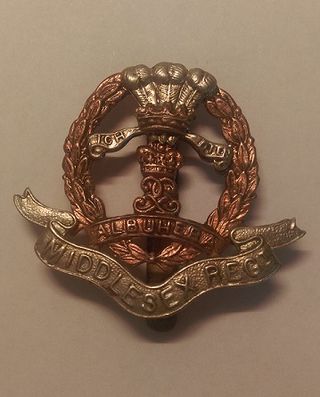
The Middlesex Regiment (Duke of Cambridge's Own) was a line infantry regiment of the British Army in existence from 1881 until 1966. The regiment was formed, as the Duke of Cambridge's Own (Middlesex Regiment), in 1881 as part of the Childers Reforms when the 57th (West Middlesex) and 77th (East Middlesex) Regiments of Foot were amalgamated with the county's militia and rifle volunteer units.
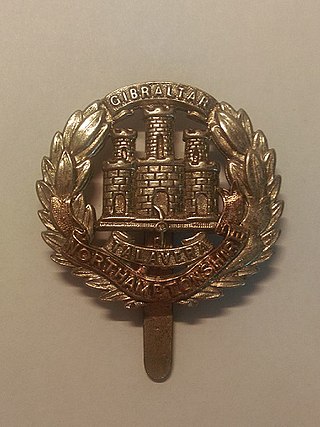
The Northamptonshire Regiment was a line infantry regiment of the British Army in existence from 1881 until 1960. In 1960, it was amalgamated with the Royal Lincolnshire Regiment to form the 2nd East Anglian Regiment, which was amalgamated with the 1st East Anglian Regiment, the 3rd East Anglian Regiment and the Royal Leicestershire Regiment to form the present Royal Anglian Regiment.

The 140th Brigade was an infantry brigade formation of the British Army's Territorial Army (TA) that had its origins in a South London Brigade of the former Volunteer Force. It served on the Western Front in the First World War and was recreated during the Second World War where it served only in the United Kingdom as a training formation.
The Wellington Infantry Regiment was a military unit of the New Zealand Expeditionary Force (NZEF) raised for service in the First World War. It saw service in the Gallipoli Campaign (1915) and on the Western Front (1916–1919). The regiment was formed by grouping together companies from four different territorial regiments base in the Wellington Military district.

The Taranaki Regiment was a territorial infantry regiment of the New Zealand Military Forces. The regiment traced its origins to the Taranaki Volunteer Rifle Company, a volunteer corps formed in 1858 and which saw service in the New Zealand Wars. The volunteer corps also provided men to the New Zealand contingents sent to South Africa during the Second Boer War and in 1911 became the 11th Regiment (Taranaki Rifles). During the First World War, the regiment provided a company to each of the battalions of the Wellington Infantry Regiment and saw combat at Galipolli and on the Western Front. After the war the regiment was renamed the Taranaki Regiment and remained in New Zealand for home defense during the Second World War. Men from the regiment, however, served with the 19th, 22nd, 25th and 36th Battalions of the Second New Zealand Expeditionary Force. In 1948, the Taranaki Regiment was amalgamated with the Wellington West Coast Regiment and became the Wellington West Coast and Taranaki Regiment.

The Wellington Regiment (City of Wellington's Own) was a territorial infantry regiment of the New Zealand Army. The regiment traced its origins to the Wellington Veteran Volunteer Corps, a volunteer corps formed in 1867 and which would later amalgamate with other volunteer corps to form the 5th (Wellington) Regiment in 1911. During the First World War, the regiment was first sent to capture German Samoa in August 1914 and was later affiliated with the New Zealand Rifle Brigade which saw combat on the Western Front. After the war, the regiment was renamed the Wellington Regiment and remained in New Zealand for home defence during the Second World War. Men from the regiment, however, served with the 19th, 22nd, 25th and 36th Battalions of the Second New Zealand Expeditionary Force. In 1964, the Wellington Regiment was amalgamated with the Hawke's Bay Regiment to become 7th Battalion (Wellington (City of Wellington's Own) and Hawke's Bay), Royal New Zealand Infantry Regiment. The 7th Battalion was itself later amalgamated with the 5th Battalion and became 5th/7th Battalion, Royal New Zealand Infantry Regiment in 2012. The traditions of the Wellington Regiment are now continued by Wellington Company, 5/7 RNZIR.

The Hawke's Bay Regiment was a territorial infantry regiment of the New Zealand Military Forces. The regiment traced its origins to the Napier Rifle Volunteer Rifles, a volunteer corps formed in 1863 and which would later amalgamate with other volunteer corps to form the 9th Regiment in 1911. During the First World War, the regiment provided a company to each of the battalions of the Wellington Infantry Regiment and saw combat at Galipolli and on the Western Front. After the war the regiment was renamed the Hawke's Bay Regiment and remained in New Zealand for home defense during the Second World War. Men from the regiment, however, served with the 19th, 22nd, 25th and 36th Battalions of the Second New Zealand Expeditionary Force. The regiment had a close relationship with the Ruahine Regiment, which was detached and reabsorbed by the Hawke's Bay regiment on two separate occasions. In 1964, the Hawkes Bay regiment was amalgamated with the Wellington Regiment and become the 7th Battalion, Royal New Zealand Infantry Regiment

The Ruahine Regiment was a Territorial Force Infantry Regiment of the New Zealand Military Forces. It was briefly raised in the 1910s and saw service in the First World War as part of the Wellington Infantry Regiment. It was formed for a second time during the Second World War and was deployed overseas as part of the 3rd Division but never saw combat.
The Wellington West Coast Regiment was a territorial infantry regiment of the New Zealand Military Forces. The regiment traced its origins to the Wanganui Rifle Volunteers, a volunteer corps formed in 1860. The volunteer corps provided men to the New Zealand contingents sent to South Africa during the Second Boer War and in 1911 became the 7th Regiment. During the First World War, the regiment provided a company to each of the battalions of the Wellington Infantry Regiment, which saw combat at Galipolli and on the Western Front. After the war the regiment was renamed the Wellington West Coast Regiment and remained in New Zealand for home defence during the Second World War. Men from the regiment, however, served with the 19th, 22nd, 25th and 36th Battalions of the Second New Zealand Expeditionary Force. In 1948, the Wellington West Coast Regiment was amalgamated with the Taranaki Regiment and became the Wellington West Coast and Taranaki Regiment.
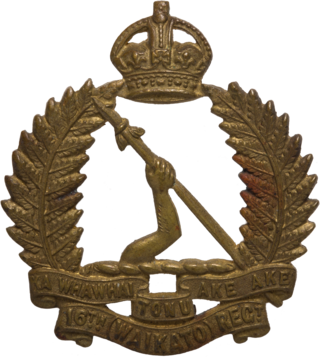
The Waikato Regiment was a territorial infantry regiment of the New Zealand Military Forces. The Regiment was formed in 1911 as the 16th (Waikato) Regiment and provided service companies to the Auckland Infantry Regiment during the First World War. Men from the Regiment also served with the 18th, 21st, 24th and 29th battalions of the 2nd New Zealand Expeditionary Force during the Second World War. The regiment was absorbed by the 1st Armoured Regiment (Waikato) of the Royal New Zealand Armoured Corps in 1950

The Northland Regiment was a territorial infantry regiment of the New Zealand Military Forces. The Regiment was formed in 1911 and provided service companies to the Auckland Infantry Regiment during the First World War. Men from the Regiment also served with the 18th, 21st, 24th and 29th battalions of the 2nd New Zealand Expeditionary Force during the Second World War. The regiment was amalgamated with the Auckland Regiment in 1964, becoming 3rd Battalion, Royal New Zealand Infantry Regiment.














